Weicong Chen
LABELING COPILOT: A Deep Research Agent for Automated Data Curation in Computer Vision
Sep 26, 2025Abstract:Curating high-quality, domain-specific datasets is a major bottleneck for deploying robust vision systems, requiring complex trade-offs between data quality, diversity, and cost when researching vast, unlabeled data lakes. We introduce Labeling Copilot, the first data curation deep research agent for computer vision. A central orchestrator agent, powered by a large multimodal language model, uses multi-step reasoning to execute specialized tools across three core capabilities: (1) Calibrated Discovery sources relevant, in-distribution data from large repositories; (2) Controllable Synthesis generates novel data for rare scenarios with robust filtering; and (3) Consensus Annotation produces accurate labels by orchestrating multiple foundation models via a novel consensus mechanism incorporating non-maximum suppression and voting. Our large-scale validation proves the effectiveness of Labeling Copilot's components. The Consensus Annotation module excels at object discovery: on the dense COCO dataset, it averages 14.2 candidate proposals per image-nearly double the 7.4 ground-truth objects-achieving a final annotation mAP of 37.1%. On the web-scale Open Images dataset, it navigated extreme class imbalance to discover 903 new bounding box categories, expanding its capability to over 1500 total. Concurrently, our Calibrated Discovery tool, tested at a 10-million sample scale, features an active learning strategy that is up to 40x more computationally efficient than alternatives with equivalent sample efficiency. These experiments validate that an agentic workflow with optimized, scalable tools provides a robust foundation for curating industrial-scale datasets.
$K^4$: Online Log Anomaly Detection Via Unsupervised Typicality Learning
Jul 26, 2025Abstract:Existing Log Anomaly Detection (LogAD) methods are often slow, dependent on error-prone parsing, and use unrealistic evaluation protocols. We introduce $K^4$, an unsupervised and parser-independent framework for high-performance online detection. $K^4$ transforms arbitrary log embeddings into compact four-dimensional descriptors (Precision, Recall, Density, Coverage) using efficient k-nearest neighbor (k-NN) statistics. These descriptors enable lightweight detectors to accurately score anomalies without retraining. Using a more realistic online evaluation protocol, $K^4$ sets a new state-of-the-art (AUROC: 0.995-0.999), outperforming baselines by large margins while being orders of magnitude faster, with training under 4 seconds and inference as low as 4 $\mu$s.
Joint Spatial Division and Multiplexing with Customized Orthogonal Group Channels in Multi-RIS-Assisted Systems
Jul 03, 2025Abstract:Reconfigurable intelligent surfaces (RISs) offer the unique capability to reshape the radio environment, thereby simplifying transmission schemes traditionally contingent on channel conditions. Joint spatial division and multiplexing (JSDM) emerges as a low-overhead transmission scheme for multi-user equipment (UE) scenarios, typically requiring complex matrix decomposition to achieve block-diagonalization of the effective channel matrix. In this study, we introduce an innovative JSDM design that leverages RISs to customize channels, thereby streamlining the overall procedures. By strategically positioning RISs at the discrete Fourier transform (DFT) directions of the base station (BS), we establish orthogonal line-of-sight links within the BS-RIS channel, enabling a straightforward pre-beamforming design. Based on UE grouping, we devise reflected beams of the RIS with optimized directions to mitigate inter-group interference in the RISs-UEs channel. An approximation of the channel cross-correlation coefficient is derived and serves as a foundation for the RISs-UEs association, further diminishing inter-group interference. Numerical results substantiate the efficacy of our RIS-customized JSDM in not only achieving effective channel block-diagonalization but also in significantly enhancing the sum spectral efficiency for multi-UE transmissions.
Channel Customization for Low-Complexity CSI Acquisition in Multi-RIS-Assisted MIMO Systems
Nov 21, 2024
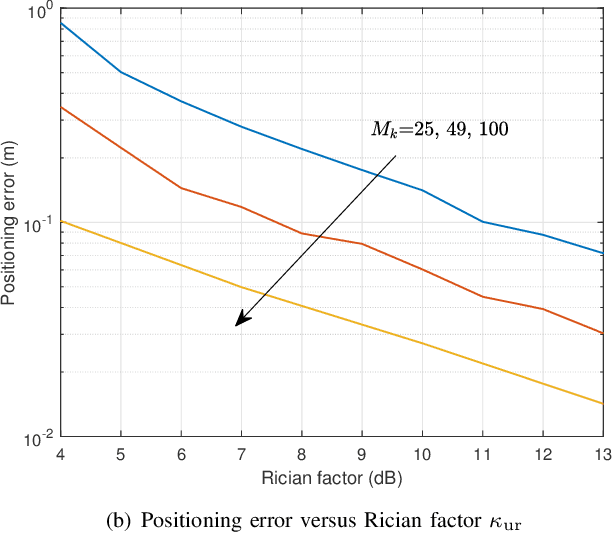
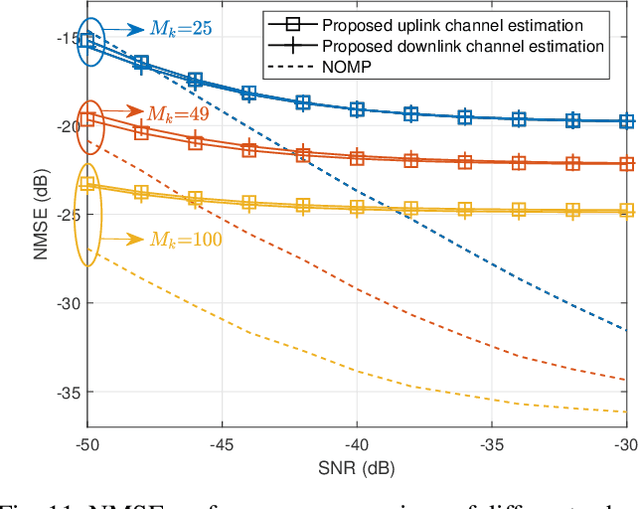

Abstract:The deployment of multiple reconfigurable intelligent surfaces (RISs) enhances the propagation environment by improving channel quality, but it also complicates channel estimation. Following the conventional wireless communication system design, which involves full channel state information (CSI) acquisition followed by RIS configuration, can reduce transmission efficiency due to substantial pilot overhead and computational complexity. This study introduces an innovative approach that integrates CSI acquisition and RIS configuration, leveraging the channel-altering capabilities of the RIS to reduce both the overhead and complexity of CSI acquisition. The focus is on multi-RIS-assisted systems, featuring both direct and reflected propagation paths. By applying a fast-varying reflection sequence during RIS configuration for channel training, the complex problem of channel estimation is decomposed into simpler, independent tasks. These fast-varying reflections effectively isolate transmit signals from different paths, streamlining the CSI acquisition process for both uplink and downlink communications with reduced complexity. In uplink scenarios, a positioning-based algorithm derives partial CSI, informing the adjustment of RIS parameters to create a sparse reflection channel, enabling precise reconstruction of the uplink channel. Downlink communication benefits from this strategically tailored reflection channel, allowing effective CSI acquisition with fewer pilot signals. Simulation results highlight the proposed methodology's ability to accurately reconstruct the reflection channel with minimal impact on the normalized mean square error while simultaneously enhancing spectral efficiency.
Rotatable Block-Controlled RIS: Bridging the Performance Gap to Element-Controlled Systems
Aug 22, 2024


Abstract:The passive reconfigurable intelligent surface (RIS) requires numerous elements to achieve adequate array gain, which linearly increases power consumption (PC) with the number of reflection phases. To address this, this letter introduces a rotatable block-controlled RIS (BC-RIS) that preserves spectral efficiency (SE) while reducing power costs. Unlike the element-controlled RIS (EC-RIS), which necessitates independent phase control for each element, the BC-RIS uses a single phase control circuit for each block, substantially lowering power requirements. In the maximum ratio transmission, by customizing specular reflection channels through the rotation of blocks and coherently superimposing signals with optimized reflection phase of blocks, the BC-RIS achieves the same averaged SE as the EC-RIS. To counteract the added power demands from rotation, influenced by block size, we have developed a segmentation scheme to minimize overall PC. Furthermore, constraints for rotation power-related parameters have been established to enhance the energy efficiency of the BC-RIS compared to the EC-RIS. Numerical results confirm that this approach significantly improves energy efficiency while maintaining performance.
Performance Evaluation for Subarray-based Reconfigurable Intelligent Surface-Aided Wireless Communication Systems
Sep 22, 2023



Abstract:Reconfigurable intelligent surfaces (RISs) have received extensive concern to improve the performance of wireless communication systems. In this paper, a subarray-based scheme is investigated in terms of its effects on ergodic spectral efficiency (SE) and energy efficiency (EE) in RIS-assisted systems. In this scheme, the adjacent elements divided into a subarray are controlled by one signal and share the same reflection coefficient. An upper bound of ergodic SE is derived and an optimal phase shift design is proposed for the subarray-based RIS. Based on the upper bound and optimal design, we obtain the maximum of the upper bound. In particular, we analytically evaluate the effect of the subarray-based RIS on EE since it reduces SE and power consumption simultaneously. Numerical results verify the tightness of the upper bound, demonstrate the effectiveness of the optimal phase shift design for the subarray-based RIS, and reveal the effects of the subarray-based scheme on SE and EE.
Rank Optimization for MIMO systems with RIS: Simulation and Measurement
Jul 25, 2023



Abstract:Reconfigurable intelligent surface (RIS) is a promising technology that can reshape the electromagnetic environment in wireless networks, offering various possibilities for enhancing wireless channels. Motivated by this, we investigate the channel optimization for multiple-input multiple-output (MIMO) systems assisted by RIS. In this paper, an efficient RIS optimization method is proposed to enhance the effective rank of the MIMO channel for achievable rate improvement. Numerical results are presented to verify the effectiveness of RIS in improving MIMO channels. Additionally, we construct a 2$\times$2 RIS-assisted MIMO prototype to perform experimental measurements and validate the performance of our proposed algorithm. The results reveal a significant increase in effective rank and achievable rate for the RIS-assisted MIMO channel compared to the MIMO channel without RIS.
Multi-timescale Channel Customization for Transmission Design in RIS-assisted MIMO Systems
May 04, 2023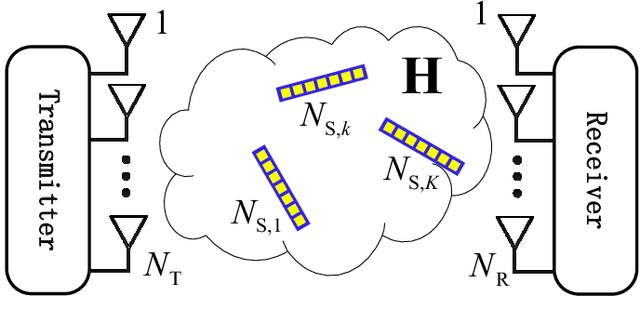
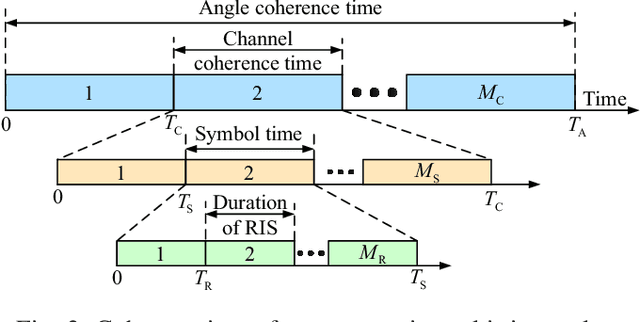
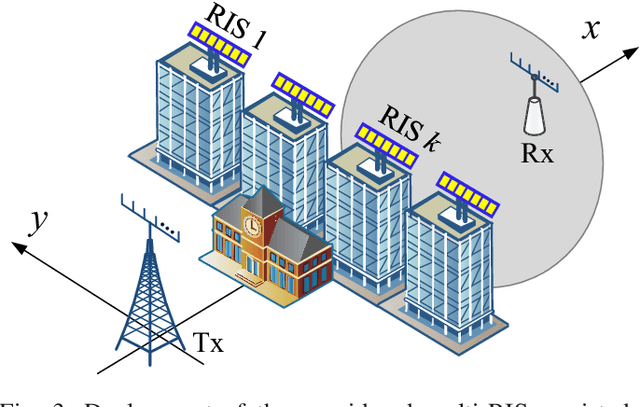
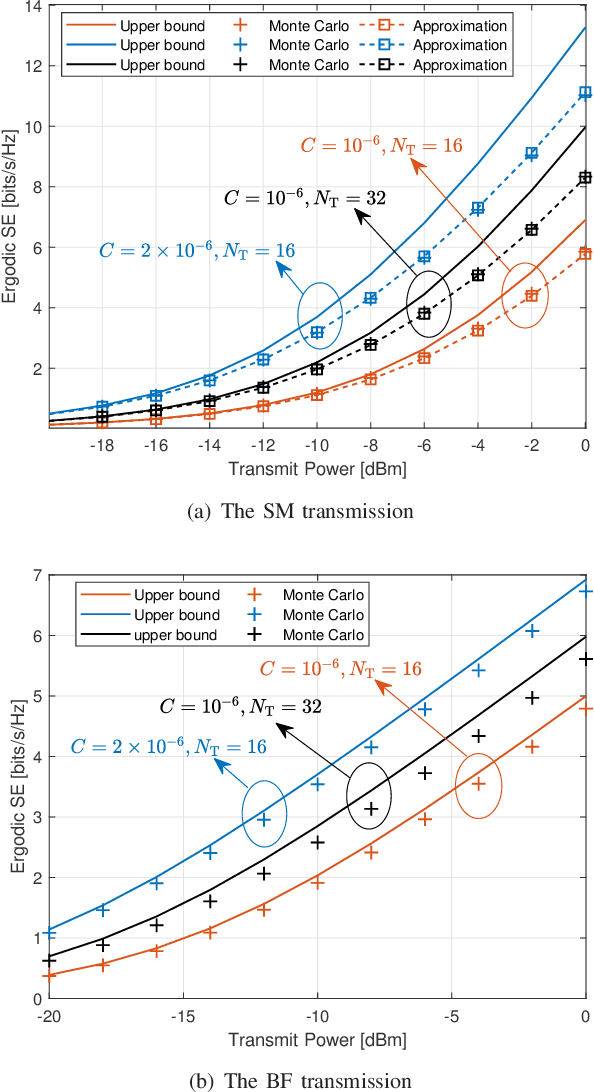
Abstract:The performance of transmission schemes is heavily influenced by the wireless channel, which is typically considered an uncontrollable factor. However, the introduction of reconfigurable intelligent surfaces (RISs) to wireless communications enables the customization of a preferred channel for adopted transmissions by reshaping electromagnetic waves. In this study, we propose multi-timescale channel customization for RIS-assisted multiple-input multiple-output systems to facilitate transmission design. Specifically, we customize a high-rank channel for spatial multiplexing (SM) transmission and a highly correlated rank-1 channel for beamforming (BF) transmission by designing the phase shifters of the RIS with statistical channel state information in the angle-coherent time to improve spectral efficiency (SE). We derive closed-form expressions for the approximation and upper bound of the ergodic SE and compare them to investigate the relative SE performance of SM and BF transmissions. In terms of reliability enhancement, we customize a fast-changing channel in the symbol timescale to achieve more diversity gain for SM and BF transmissions. Extensive numerical results demonstrate that flexible customization of channel characteristics for a specific transmission scheme can achieve a tradeoff between SE and bit error ratio performance.
Channel Customization for Limited Feedback in RIS-assisted FDD Systems
May 03, 2023Abstract:Reconfigurable intelligent surfaces (RISs) represent a pioneering technology to realize smart electromagnetic environments by reshaping the wireless channel. \textcolor[rgb]{0,0,0}{Jointly designing the transceiver and RIS relies on the channel state information (CSI), whose feedback has not been investigated in multi-RIS-assisted frequency division duplexing systems.} In this study, the limited feedback of the RIS-assisted wireless channel is examined by capitalizing on the ability of the RIS in channel customization. \textcolor[rgb]{0,0,0}{By configuring the phase shifters of the surfaces using statistical CSI, we customize a sparse channel in rich-scattering environments, which significantly reduces the feedback overhead in designing the transceiver and RISs. Since the channel is customized in terms of singular value decomposition (SVD) with full-rank, the optimal SVD transceiver can be approached without a matrix decomposition and feeding back the complete channel parameters. The theoretical spectral efficiency (SE) loss of the proposed transceiver and RIS design is derived by considering the limited CSI quantization. To minimize the SE loss, a bit partitioning algorithm that splits the limited number of bits to quantize the CSI is developed.} Extensive numerical results show that the channel customization-based transceiver with reduced CSI can achieve satisfactory performance compared with the optimal transceiver with full CSI. Given the limited number of feedback bits, the bit partitioning algorithm can minimize the SE loss by adaptively allocating bits to quantize the channel parameters.
Channel Customization for Joint Tx-RISs-Rx Design in Hybrid mmWave systems
Sep 27, 2021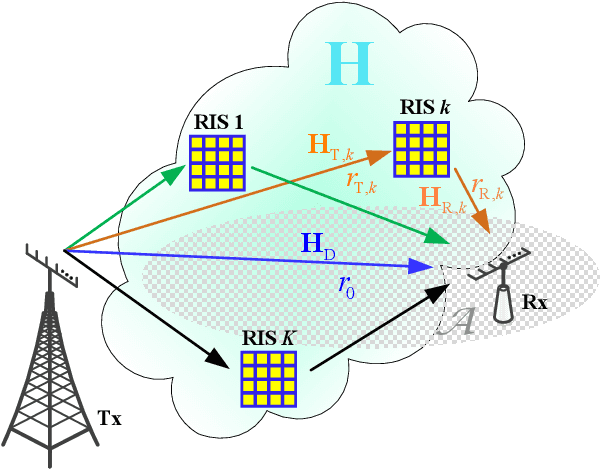
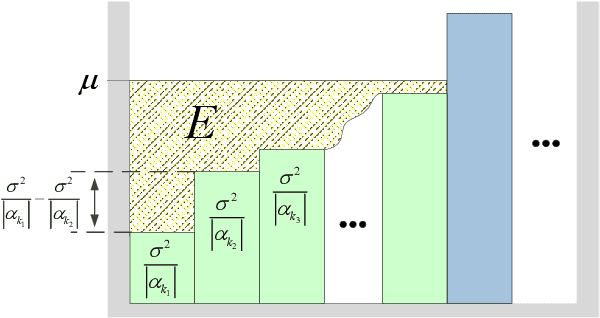
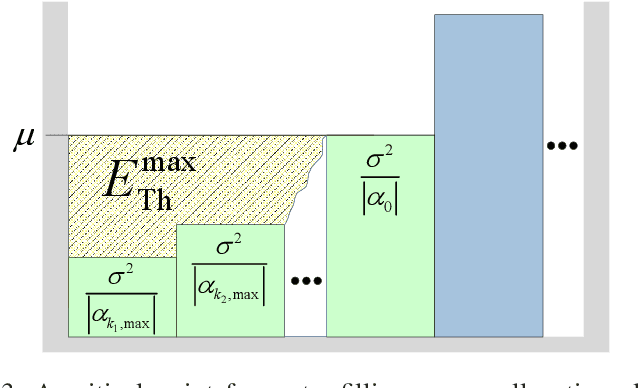
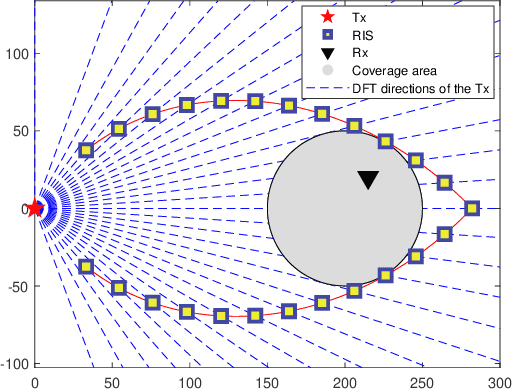
Abstract:In strong line-of-sight millimeter-wave (mmWave) wireless systems, the rank-deficient channel severely hampers spatial multiplexing. To address this inherent deficiency, distributed reconfigurable intelligent surfaces (RISs) are introduced in this study to customize the wireless channel. Capitalizing on the ability of the RIS to reshape electromagnetic waves, we theoretically show that a favorable channel with an arbitrary tunable rank and a minimized truncated condition number can be established by elaborately designing the placement and reflection matrix of RISs. Different from existing works on distributed RISs, the number of elements needed for each RIS to combat the path loss and the limited phase control is also considered in this research. On the basis of the proposed channel customization, a joint transmitter-RISs-receiver (Tx-RISs-Rx) design under a hybrid mmWave system is investigated to maximize the downlink spectral efficiency. Using the proposed scheme, the optimal singular value decomposition-based hybrid beamforming at the Tx and Rx can be easily obtained without matrix decomposition for the digital and analog beamforming. The bottoms of the sub-channel mode in the water-filling power allocation algorithm, which are conventionally uncontrollable when the noise power is fixed, are proven to be independently adjustable by RISs. Moreover, the transmit power required for realizing multi-stream transmission is derived. Numerical results are presented to verify our theoretical analysis and exhibit substantial gains over systems without RISs.
 Add to Chrome
Add to Chrome Add to Firefox
Add to Firefox Add to Edge
Add to Edge